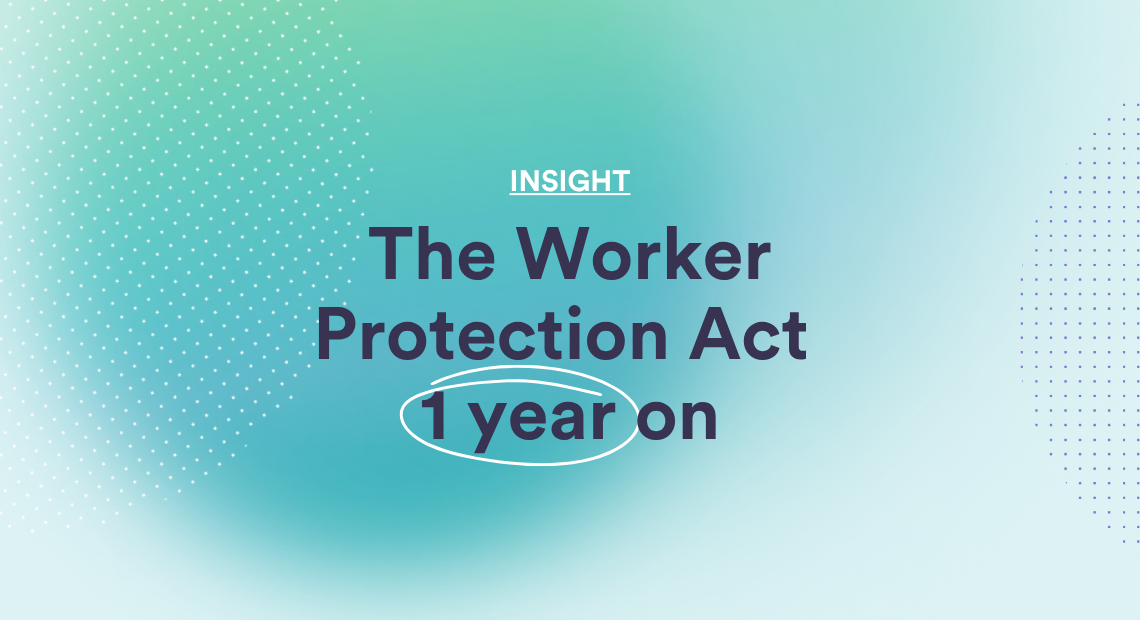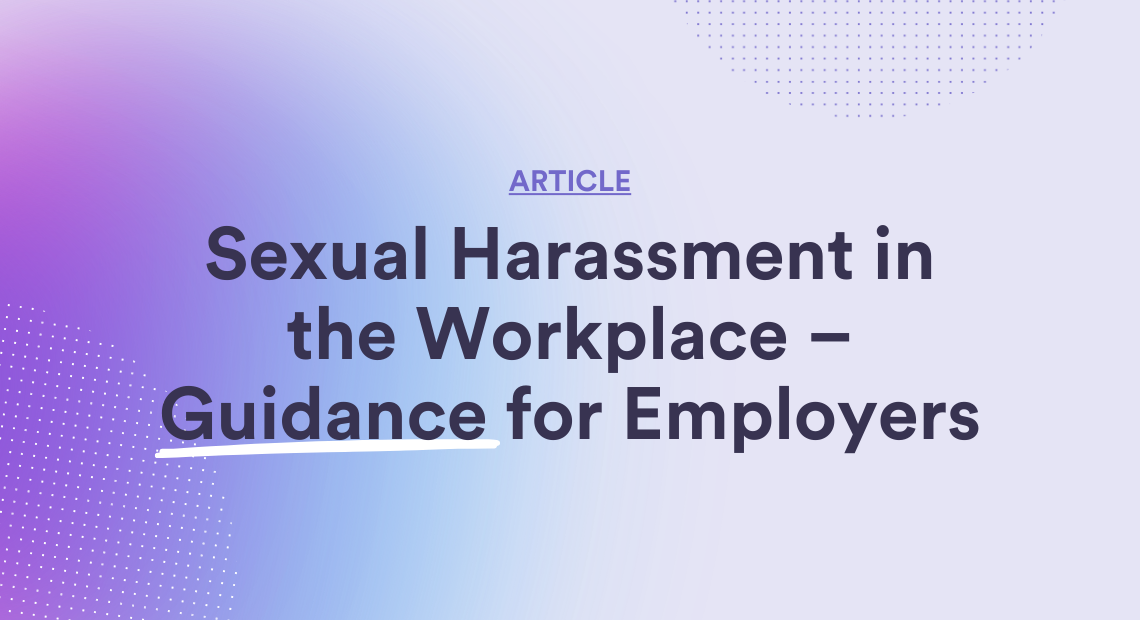The state of workplace compliance – the impact of the new Worker Protection Act 1 year on
The Worker Protection Act came into force in October 2024 and placed a new legal obligation on employers to take ‘reasonable steps’ to actively prevent sexual harassment in the workplace. The new legal duty requires employers to take a more proactive approach to eliminating sexual misconduct, rather than responding to sexual harassment claims under the previous legislation.
One year on, are employers complying with the new legislation and are more employees speaking up when it comes to reporting sexual harassment at work?
Steps for compliance with the Worker Protection Act
To comply with the Worker Protection Act, employers must take reasonable steps to prevent the sexual harassment of their workers, and what is classed as ‘reasonable’ will vary between employers. The Equality and Human Rights Commission (EHRC) have produced a set of Technical Guidance notes for employers and whilst they do not provide a definitive list of steps an employer should take to prevent sexual harassment at work, an employer should:
- consider the risks of sexual harassment occurring in the course of employment
- consider what steps it could take to reduce those risks and prevent sexual harassment of their workers
- consider which of those steps it would be reasonable for it to take
- implement those reasonable steps
A few examples the EHRC give as key actions are:
- Conduct a sexual harassment risk assessment and consider the reasonable steps to take
- Specific training for managers to ensure they understand what sexual harassment is and that any reports of sexual misconduct (formal or informal) are documented and taken seriously, followed up with appropriate action
- Refresher training for all staff with an emphasis on inclusion, respectful behaviour and the importance of reporting sexual harassment they see or experience
- Setting up anonymous reporting channels to encourage staff to speak up, particularly to ensure psychological safety when power dynamics are present and could be fearful of identifying themselves
- Setting up a data protection compliant evidence hub to record all instances of sexual harassment and commit to reviewing data and trends regularly to evaluate the effectiveness of the actions taken to prevent sexual harassment
Increase in sexual harassment reports
ACAS, the independent public body that helps improve workplace relationships and resolves disputes, recorded a 39% increase in calls to their helpline in the first six months of 2025 (in comparison to the same time period in 2024) from both employees and employers requesting advice about sexual harassment.
This surge in enquiries align with the introduction of the Worker Protection Act coming into force in October 2024. The increase in calls suggests that not only are more incidents and reports being made, indicating an increased awareness but employers are uncertain about what steps are legally required to comply with the Act and ensure they have taken reasonable steps to prevent sexual harassment.
ACAS supports both employers and employees, and whilst the nature of the calls have not been disclosed, the increase in calls in relation to sexual harassment could indicate that:
- Workplaces haven’t yet done enough to give employees the confidence to speak up directly to their employer. This could mean they have not implemented an anonymous reporting channel or improved their current reporting mechanisms, employees may not know how to make a report and therefore are calling ACAS, an outside body, to essentially report ‘anonymously’, seeking external support.
- Employers haven’t provided adequate training to employees and managers and therefore employees are calling ACAS to help them understand if they are experiencing sexual harassment.
- Employers are unclear how to respond to instances and are seeking support from the ACAS helpline to help understand their legal duty.
Concerns of under reporting and lack of reporting channels
Whilst ACAS’s helpline statistics indicate an early rise in reporting, our own research in 2024 found that 41% of organisations had no reporting pathway in place, whilst a survey by Personio reported that only 18% of employees felt there was an accessible or anonymous way to report misconduct in their organisation. Similarly, 18% doubted their organisation’s ability to protect their anonymity when reporting misconduct.
However the counter argument from employers is that they cite employee communication as the biggest barrier for them to address sexual harassment, indicating employees either do not feel comfortable with current reporting channels or know who or how to report incidents.
Whatever way you look at it, despite the introduction of the WPA, there are still concerns that sexual harassment and other forms of workplace misconduct are being under reported. With no clear statistics currently as to how many employers have implemented an anonymous reporting channel since the new legislation came into force, using the data above that we can surmise there’s still a way to go from employers, to not only provide a reporting mechanism but to improve employee confidence in reporting, breaking down barriers and building a speak up culture across workplaces.
With the upcoming Employment Rights Bill, strengthening the rules around sexual harassment, extending obligations from ‘reasonable steps’ to ‘all reasonable steps’ and increased liability for employers to prevent third-party sexual harassment, employers need to address the lack of reporting now in order to comply with the new legislation.
Training
SME news reported that one e-learning business had seen a steep increase in demand for sexual harassment courses, with a monthly demand increase of 300% from October 2024, when the WPA came into force. Similarly another e-learning provider reported a 1,213% year-on-year increase in completions of their sexual harassment awareness course indicating employers are aware of the training requirements under the new legislation.
Google Trends data also showed a spike in searches for sexual harassment training in the UK throughout November 2024 and another spike at the start of April 2025, which aligns to the new financial year for many organisations. It could signal a new budget for training and a renewed commitment to roll out sexual harassment training.
However, it’s unclear how widespread this training is across all employers and the completion of training courses does not necessarily equate to effective and engaged outcomes, particularly if the training has been delivered once and not put into practice.
Whilst exact figures are lacking, it’s evident that many employers are still in the process of adapting to the new requirements and that there is still a long way to go to improve employee confidence when it comes to reporting sexual harassment at work.
The Employment Rights Bill which is expected to be made law in late 2025 will continue to strengthen employers duties around preventing sexual harassment, raising the bar for liability. Employers will need to go beyond traditional policies and really consider prevention mechanisms in their workplace to ensure they are demonstrating they have taken all reasonable steps to prevent harassment.
Employers need to continue building trust in reporting mechanisms, whether that’s improving what is already in place or implementing a new anonymous reporting channel to increase reporting and improve employee confidence when it comes to speaking up to comply with their expanding legal duties.




